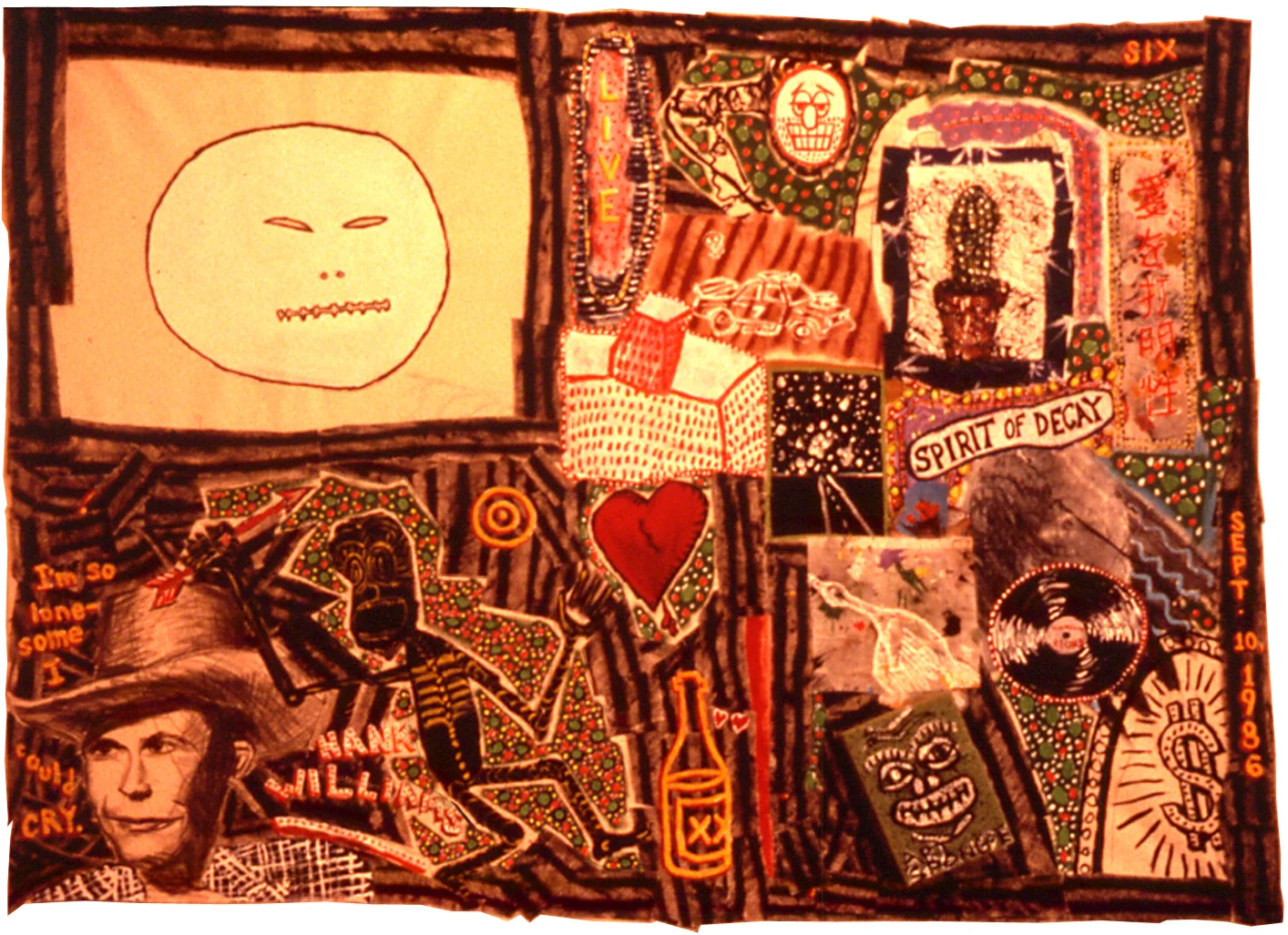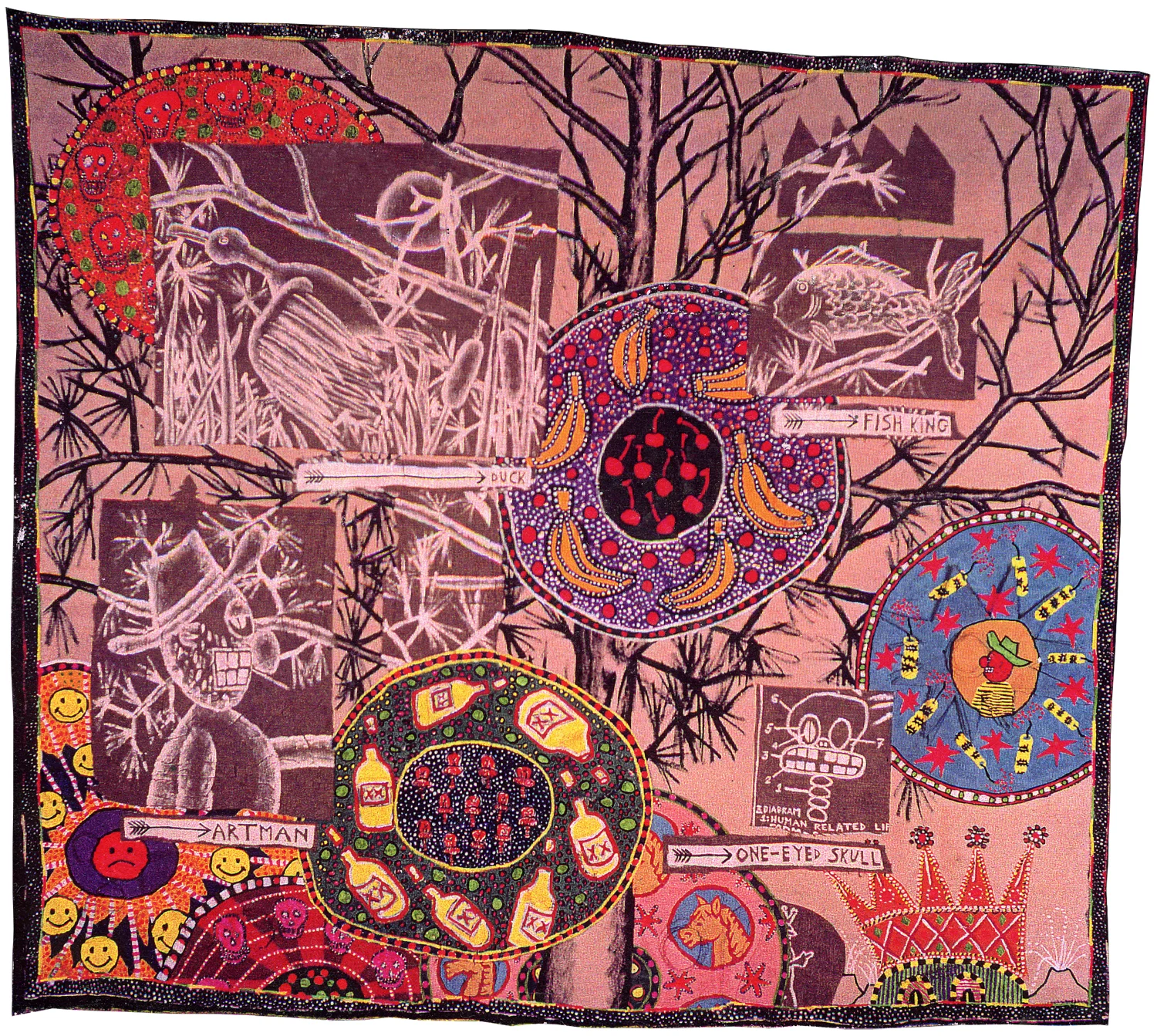Funk 1984 / 1987
Patching Across America
This period was a radical 180 degree shift from the driving concerns of the prior abstract work - purity, emotional presence, mostly non-objective, with an emphasis on paint materiality. The power of ideas imploded upon my purely intuitive method of working, and these new pieces evoked my evolving concerns. I wanted these pieces to be more anecdotal, to tell a sort of story, loosely metaphorical, not literal, with a figurative vocabulary any one could get something out of. I loved the universe of abstraction, but had become more democratic in my thinking, more feeling like art should be for people in the big sense, and not only the educated few. The irony was that the abstractionists thought they had developed a universal language, only to realize that for most people the abstract visual language was oblique and devisive, and made the uninitiated feel dumb.
Thus I developed a figurative language rendered with a more folk-like, popular touch. But I still wanted to retain the surface richness of the abstractions - but get there quick, without
building up layer upon layer of oil paint. Surface quality is a huge component of what makes paintings unique. In this case I created aggressively patched surfaces out of swatches of cotton duck and linen, and then painted on that, and made edits with the patches as well. These surfaces evolved and became an integral part of the geology of the pieces, imbuing them with a life that distinguishes them far beyond the reproduced image.
I was obsessed at the time with a certain aspect of the American sensibility, and it's collective, inherited history, and issues of class, race, romance and gender. And how all that seemed to be contained in the look of America's built landscape and it's exaggerated commercial signage, and how that tone impacts our psyches and ways of being.
Click images to see full paintings.
Review by art critic Gerard Haggerty:
Steve Sas Schwartz at the Alexander Wood Gallery, NYC 1986 by Gerard Haggerty
The raw canvas collages in Schwartz’ second New York solo show push the Protestant work ethic to subversive extremes. His stained and scumbled images crowd together sources from popular and primitive art. The works are decorated with indecorous things: cartooned imps and stylized skeletons cavort alongside candy wrappers. Pin-ups are juxtaposed next to exotic pictographs, and glittering nocturnal landscapes are painted on surfaces embellished with Kitty Litter. The complex arrangements appear aleatory, like layers of anonymous graffiti, or the improvised collaborations the the Surrealists called “exquisite corpses.”
Schwartz favors provocative puzzles instead of answers. In addition to all that we see, who knows what details lurk underneath the collaged surfaces? Prodigious energy is won at the expense of coherence. This difficulty is also a source of power, for tension exists between the viewer’s wish to edit and the abundance of data confounding that desire. If the incorporated fragments were excerpted from their overwhelming surroundings, many of them could stand alone as finished paintings. The stark simplicity of MYSTERY TRAIN, in which a collaged aluminum
railroad snakes across a black barren landscape, indicates the potential strength of such images. In the context of this otherwise monochromatic work, flecks of red paint on its thorny border seem to outshine the day-glow palette of Schwartz’ adjacent assemblages.
DEVIL’S TRAIN, a knee-high sculpture fabricated out of canvas, couples the artist’s pluralistic ambitions with a simple framing device. Beginning as a pram and concluding with a caboose labeled ‘The End’, Schwartz’ 20’ long vehicle creates a metaphorical image of life. Substituted for a locomotive is an antique baby carriage in which a small head nestles next to sacks o money. The infant’s optimistic grin contrasts with the whorled face of the conductor hunched behind him. Triangular snips of blackened cloth hang from this tall figure’s doweled limbs, suggesting dead leaves or charred fireworks. Linked by a thick rusty chain are five cut-away cars that each contain a whimsical tableau. Like chapters, the separate cars establish relationships between disparate parts. Throughout the ensemble, there is the persistent sense of hilarity in the face of death.
Schwartz’ patchwork world creates a sense of richness, confusion, and at times profound depth.




















